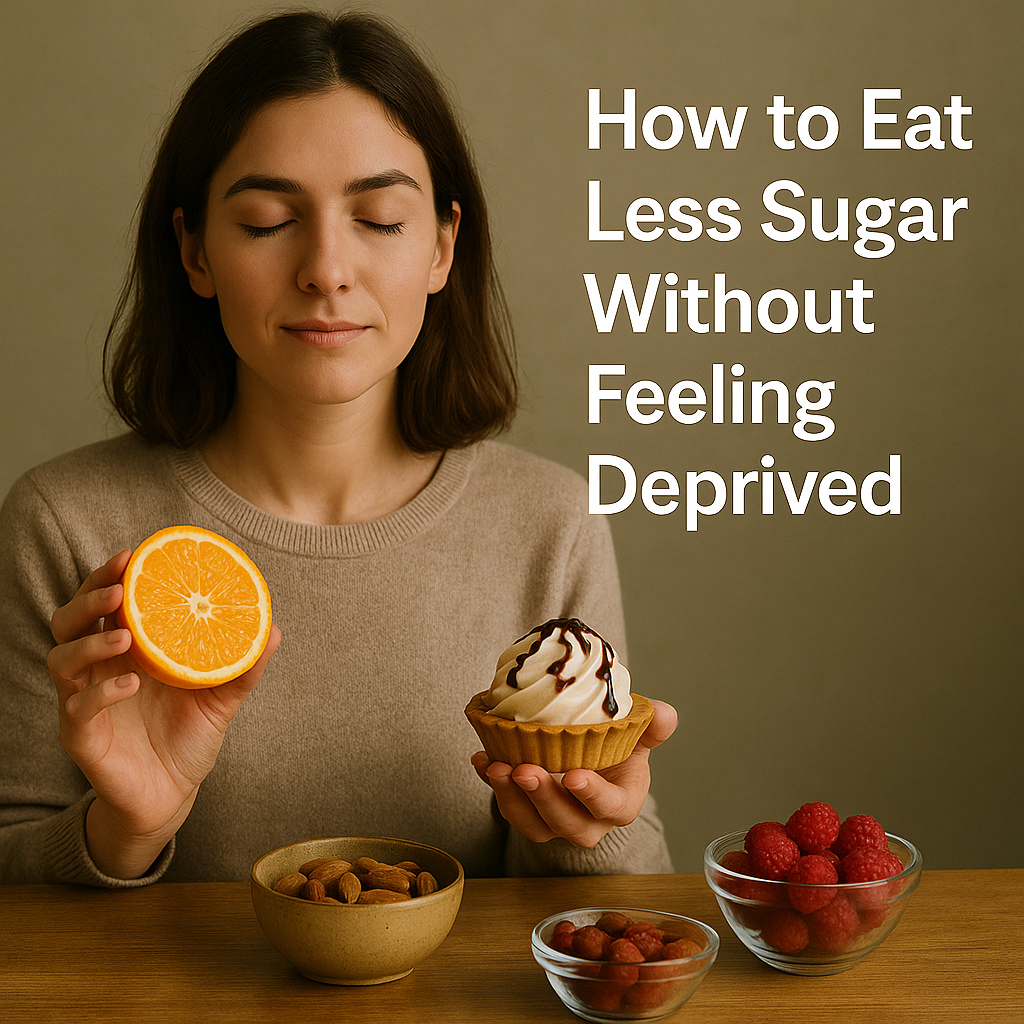Sugar is everywhere—in your coffee, in your snacks, even hidden in “healthy” foods like granola or salad dressing. While sugar can provide a quick burst of energy, consuming too much of it regularly can lead to serious health issues, from fatigue and mood swings to diabetes and heart problems.
But here’s the challenge: sugar is addictive, comforting, and often part of our routines. So how do you reduce sugar without feeling like you’re giving up all your favorite things?
In this article, we’ll explore realistic and sustainable ways to cut back on sugar—without crash diets or deprivation.
Why Is Sugar So Hard to Quit?
When you eat sugar, your brain releases dopamine—the feel-good chemical. This creates a short-term high followed by a crash, leaving you craving more.
The more often you consume sugar, the more your brain adapts, and the more you need to feel the same pleasure. That’s why sugar is considered habit-forming, and why cutting it can feel difficult.
But the benefits of reducing sugar are enormous:
- Improved energy and focus
- Better mood stability
- Fewer cravings and crashes
- Clearer skin
- Reduced risk of chronic disease
Step 1: Identify Hidden Sugars
Many processed foods contain added sugars under different names. Learn to recognize them.
Common aliases for sugar:
- High-fructose corn syrup
- Dextrose
- Maltose
- Cane juice
- Glucose
- Sucrose
- Agave nectar
- Rice syrup
Read the ingredients list, not just the nutrition label. If sugar is in the top 3 ingredients—or if multiple sugar types appear—it’s likely a high-sugar item.
Step 2: Don’t Go Cold Turkey
Quitting sugar all at once can lead to withdrawal symptoms like headaches, fatigue, or irritability. A gradual reduction is more sustainable.
Try this:
- Reduce the sugar in your coffee or tea slowly
- Choose smaller portions of sweets
- Cut sugary drinks down before cutting them out
- Replace one dessert a week with a healthier option
This keeps your taste buds from going into shock.
Step 3: Balance Your Blood Sugar
Cravings often come from blood sugar imbalances. When you eat sugary foods alone, your glucose spikes and crashes, making you crave more.
To stabilize your blood sugar:
- Eat protein with every meal
- Include fiber-rich veggies and whole grains
- Add healthy fats like nuts, seeds, or avocado
- Avoid skipping meals
Balanced meals keep you fuller longer—and reduce sugar cravings.
Step 4: Replace, Don’t Restrict
Instead of focusing on what you “can’t” have, focus on what you can enjoy.
Smart swaps:
- Soda → Sparkling water with lemon or berries
- Ice cream → Greek yogurt with fruit and cinnamon
- Candy → Dates with peanut butter or dark chocolate
- Sweet cereal → Oats with banana and walnuts
- Store-bought bars → Homemade energy bites with oats and nuts
These options still satisfy your sweet tooth—without the crash.
Step 5: Retrain Your Taste Buds
The more sugar you eat, the less sensitive you become to sweetness. But the opposite is also true: when you reduce sugar, your taste buds adapt.
After a few weeks, you may find that:
- Fruit tastes sweeter
- Store-bought desserts taste too intense
- You crave natural foods more than processed ones
Be patient—your preferences will shift with time.
Step 6: Upgrade Your Snacks
Snacking is often where sneaky sugars slip in. Choose snacks that are satisfying, not just sweet.
Better snack ideas:
- Apple slices with almond butter
- Hard-boiled eggs and cherry tomatoes
- Hummus and carrot sticks
- Plain popcorn with olive oil and herbs
- A small handful of mixed nuts
These snacks provide energy without the sugar rollercoaster.
Step 7: Watch Your Beverages
Drinks are one of the biggest sources of added sugar. That includes:
- Sodas
- Fruit juices
- Sports drinks
- Sweetened iced teas
- Flavored coffees
Try these instead:
- Herbal tea
- Infused water
- Black coffee or unsweetened almond milk lattes
- Coconut water (in moderation)
Once you remove sugar from your drinks, your total intake drops significantly.
Step 8: Read Labels Carefully
Even foods labeled “natural,” “organic,” or “low-fat” can be sugar bombs.
Look out for:
- Yogurt (especially flavored)
- Salad dressings
- Sauces like ketchup or BBQ
- Energy bars
- Instant oatmeal packets
- Plant-based milks (flavored ones especially)
Opt for unsweetened or make your own versions when possible.
Step 9: Address Emotional Eating
We often reach for sugar not out of hunger, but out of boredom, stress, or habit.
Try this instead:
- Journal how you’re feeling
- Go for a quick walk
- Call a friend
- Sip herbal tea
- Practice deep breathing
Learning to cope with emotions without food is a key step in reducing sugar naturally.
Step 10: Celebrate Progress, Not Perfection
You don’t have to quit sugar completely to be healthier. Focus on progress:
- Maybe you swapped one soda for water
- Maybe you used half the sugar in your coffee
- Maybe you chose fruit instead of a cookie
These small wins add up and create long-term change.
Final Thoughts: Sweet Life, Balanced Life
Reducing sugar isn’t about punishment—it’s about freedom. Freedom from crashes. Freedom from cravings. Freedom to eat in a way that supports your energy, mood, and health.
You don’t have to do it all at once. Take one step. Make one swap. Tune in to how you feel.
Over time, you’ll discover that a life with less sugar isn’t less sweet—it’s just sweeter in a better way.

